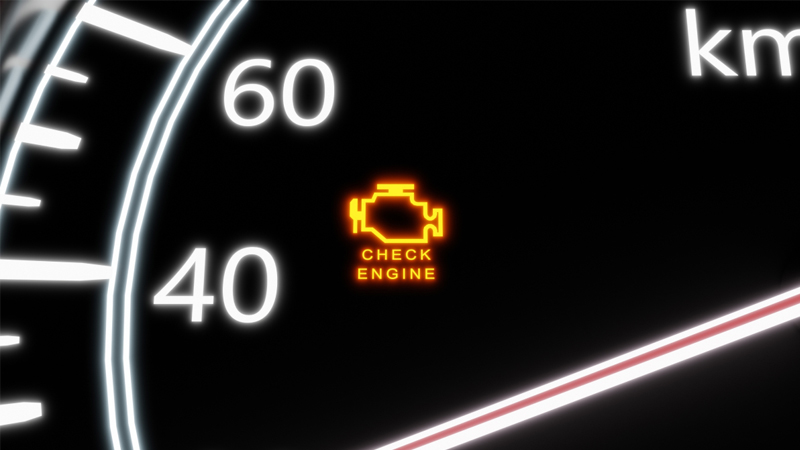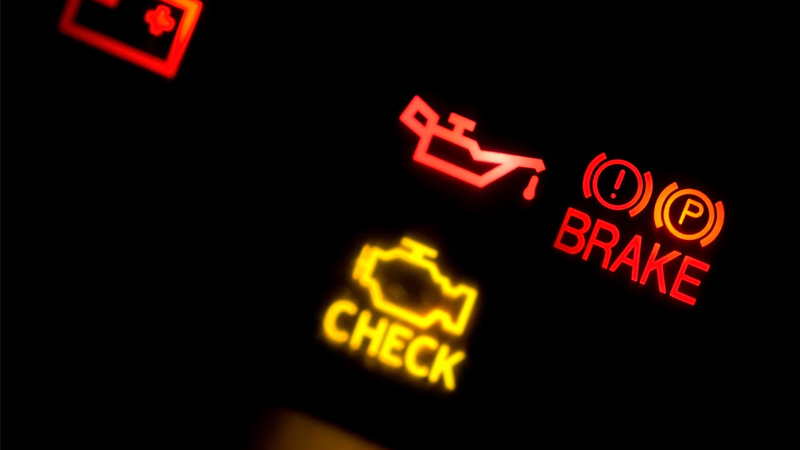Introduction

The dashboard warning lights in a vehicle play a crucial role in ensuring the safety and proper functioning of the car. Among these lights, the Check Engine Light (CEL) is one of the most significant and often misunderstood indicators. When it illuminates, it signals potential issues within the engine or emissions system, prompting drivers to take action. This article explores the causes of the check engine light, how to diagnose it, and what actions to take to keep your car running smoothly.
What Is the Check Engine Light?

The check engine light, also known as the malfunction indicator lamp (MIL), is part of a vehicle’s onboard diagnostics system (OBD-II). It appears as a yellow or orange engine-shaped symbol on the dashboard and serves as an early warning system for possible engine-related issues. When it lights up, it means the car’s computer has detected a problem that requires attention.
Common Causes of the Check Engine Light
Several issues can trigger the check engine light. Some of the most common reasons include:
(1) Loose or Faulty Gas Cap
A loose, damaged, or missing gas cap can cause fuel vapors to escape, affecting the vehicle’s emissions system. This minor issue can sometimes trigger the check engine light.
(2) Faulty Oxygen Sensor
The oxygen sensor monitors the level of unburned oxygen in the exhaust. A malfunctioning sensor can lead to decreased fuel efficiency and increased emissions, causing the check engine light to activate.
(3) Catalytic Converter Issues
A failing catalytic converter affects a car’s ability to reduce harmful emissions. If this component malfunctions, it can cause poor engine performance and trigger the check engine light.
(4) Mass Airflow Sensor Malfunction
The mass airflow (MAF) sensor measures the amount of air entering the engine. If it malfunctions, the engine may run too lean or too rich, resulting in poor fuel economy and increased emissions.
(5) Faulty Spark Plugs or Ignition Coils
Worn-out spark plugs or ignition coils can lead to engine misfires, reduced fuel efficiency, and an illuminated check engine light.
(6) Issues with the EGR Valve
The exhaust gas recirculation (EGR) valve reduces nitrogen oxide emissions by recirculating a portion of exhaust gases into the engine. If it becomes clogged or fails, the check engine light may come on.
(7) Battery and Charging System Problems
A weak or failing battery, alternator issues, or electrical faults can affect the vehicle’s electronics, leading to an illuminated check engine light.
How to Diagnose the Check Engine Light
When the check engine light turns on, it’s essential to diagnose the problem to determine the appropriate action. Here’s how:
(1) Observe the Light Behavior
+ Steady Light: Indicates a non-urgent issue that should be checked soon.
+ Flashing Light: Suggests a serious problem, such as an engine misfire, which requires immediate attention.
(2) Use an OBD-II Scanner
An OBD-II scanner reads the diagnostic trouble codes (DTCs) stored in the vehicle’s computer. These codes provide clues about the underlying issue.
(3) Check for Other Symptoms
Pay attention to other symptoms such as rough idling, decreased fuel efficiency, engine hesitation, or unusual noises, which may help pinpoint the problem.
What to Do When the Check Engine Light Comes On

Once you identify the issue, you can take appropriate action:
(1) Check the Gas Cap
If the check engine light appears shortly after refueling, check if the gas cap is properly tightened. If damaged, replace it.
(2) Inspect Visible Components
Look for disconnected wires, damaged hoses, or obvious leaks that might be causing the issue.
(3) Use an OBD-II Scanner for Diagnosis
If you have access to an OBD-II scanner, retrieve the trouble codes and research their meanings to determine the next steps.
(4) Visit a Mechanic
If you cannot resolve the issue, visit a professional mechanic to conduct further diagnostics and repairs.
Preventing Check Engine Light Issues
To minimize the chances of the check engine light turning on, follow these maintenance tips:
+ Regularly service your vehicle as per the manufacturer’s recommendations.
+ Replace air filters, spark plugs, and sensors at the recommended intervals.
+ Ensure the gas cap is secure after refueling.
+ Keep the battery and charging system in good condition.
+ Use high-quality fuel to prevent carbon buildup in the engine.
Other Important Dashboard Warning Lights
While the check engine light is critical, there are other important dashboard warning lights that drivers should be aware of:
(1) Oil Pressure Warning Light
Indicates low oil pressure, which can lead to severe engine damage if ignored.
(2) Battery Warning Light
Signals an issue with the charging system, which may result in battery failure.
(3) Brake System Warning Light
Indicates potential issues with the braking system, such as low brake fluid or a failing brake component.
(4) Coolant Temperature Warning Light
Alerts the driver when the engine temperature is too high, which can lead to overheating.
(5) ABS Warning Light
Indicates a malfunction in the anti-lock braking system (ABS), which can affect braking efficiency.
(6) Tire Pressure Monitoring System (TPMS) Light
Warns when tire pressure is too low, which can impact fuel efficiency and tire wear.
Conclusion
The check engine light is an essential component of a car’s dashboard warning lights system. While it may indicate a minor issue like a loose gas cap, it can also signal severe engine problems. Understanding the causes, diagnosing the issue using an OBD-II scanner, and taking prompt action can prevent costly repairs and ensure vehicle safety. Regular maintenance and awareness of other dashboard warning lights contribute to a smoother driving experience and longer vehicle lifespan. If the check engine light remains on, it’s best to consult a professional mechanic for proper diagnostics and repairs.

